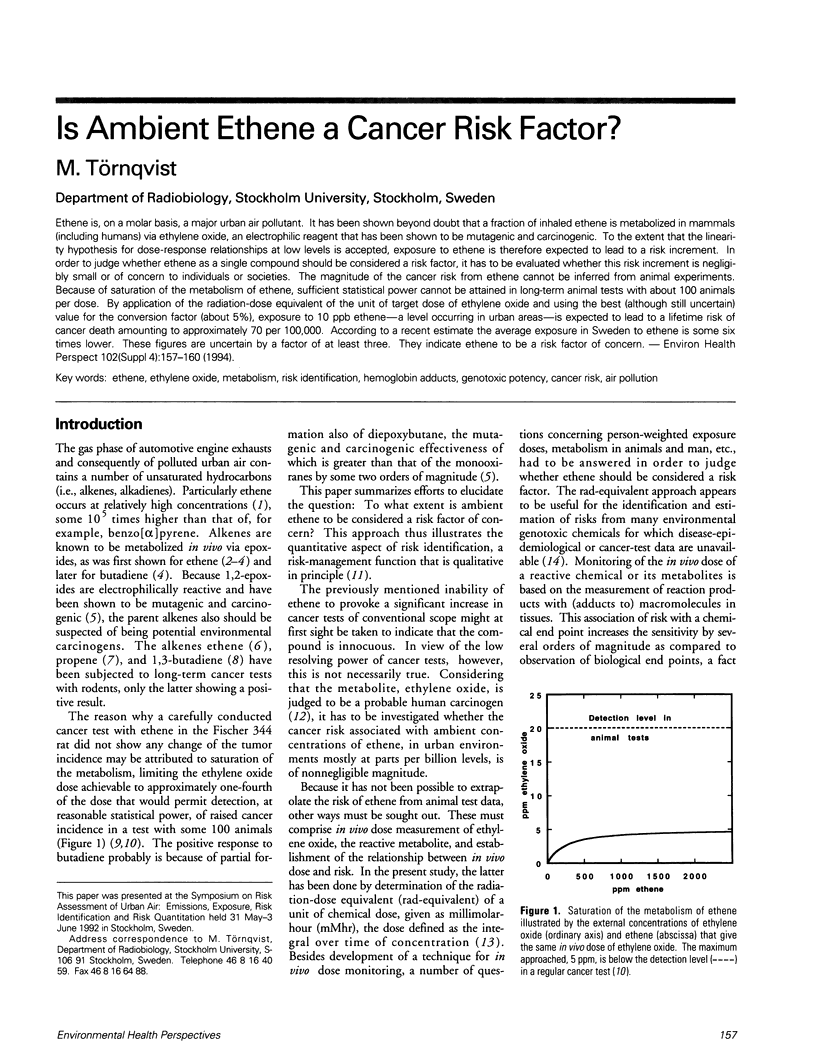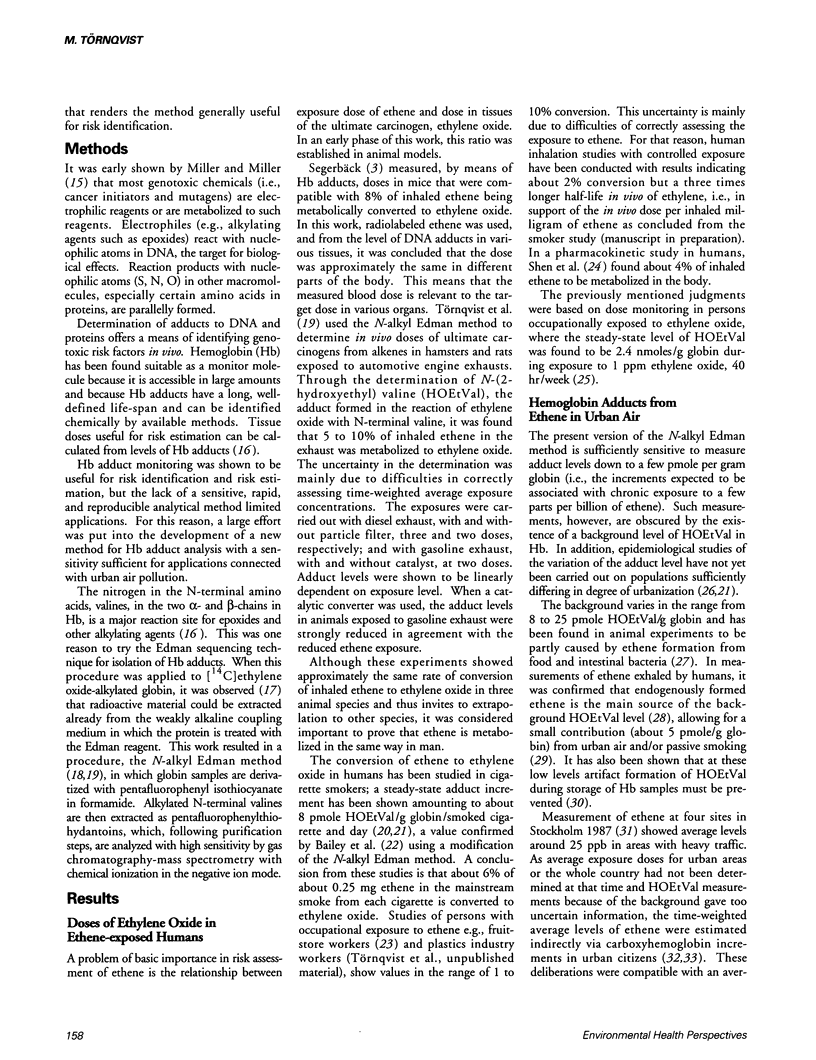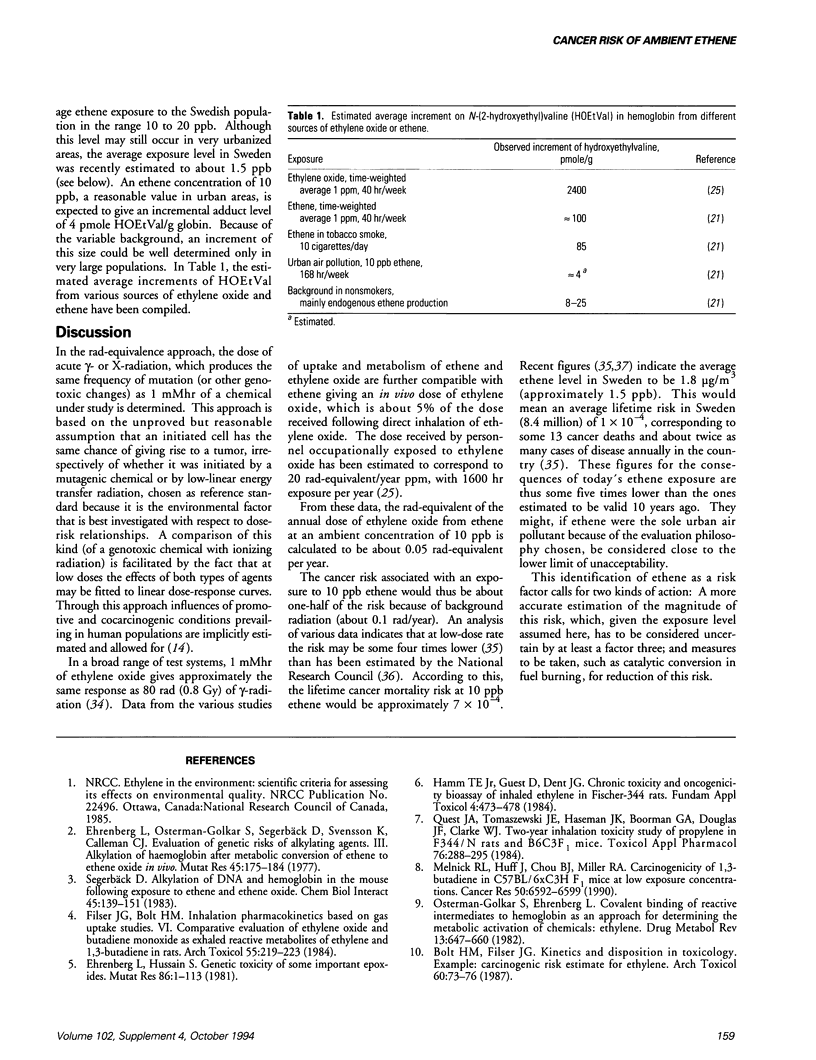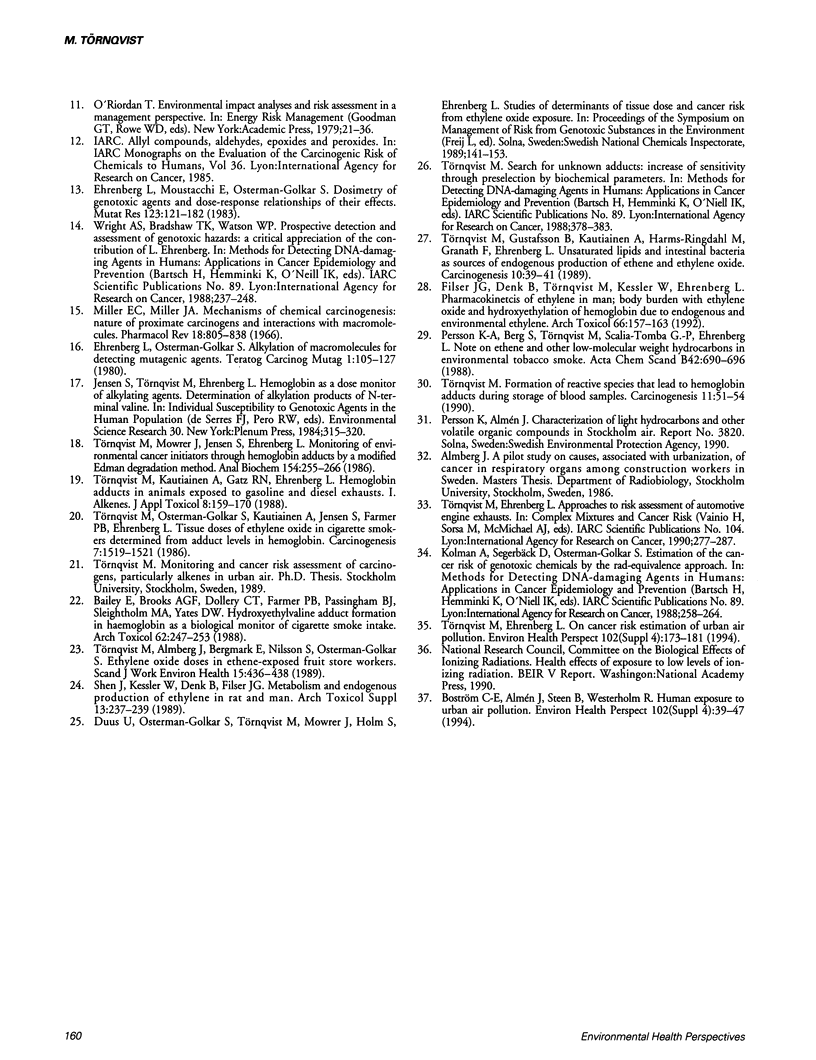Abstract
Ethene is, on a molar basis, a major urban air pollutant. It has been shown beyond doubt that a fraction of inhaled ethene is metabolized in mammals (including humans) via ethylene oxide, an electrophilic reagent that has been shown to be mutagenic and carcinogenic. To the extent that the linearity hypothesis for dose-response relationships at low levels is accepted, exposure to ethene is therefore expected to lead to a risk increment. In order to judge whether ethene as a single compound should be considered a risk factor, it has to be evaluated whether this risk increment is negligibly small or of concern to individuals or societies. The magnitude of the cancer risk from ethene cannot be inferred from animal experiments. Because of saturation of the metabolism of ethene, sufficient statistical power cannot be attained in long-term animal tests with about 100 animals per dose. By application of the radiation-dose equivalent of the unit of target dose of ethylene oxide and using the best (although still uncertain) value for the conversion factor (about 5%), exposure to 10 ppb ethene--a level occurring in urban areas--is expected to lead to a lifetime risk of cancer death amounting to approximately 70 per 100,000. According to a recent estimate the average exposure in Sweden to ethene is some six times lower. These figures are uncertain by a factor of at least three. They indicate ethene to be a risk factor of concern.
Full text
PDF



Selected References
These references are in PubMed. This may not be the complete list of references from this article.
- Bailey E., Brooks A. G., Dollery C. T., Farmer P. B., Passingham B. J., Sleightholm M. A., Yates D. W. Hydroxyethylvaline adduct formation in haemoglobin as a biological monitor of cigarette smoke intake. Arch Toxicol. 1988;62(4):247–253. doi: 10.1007/BF00332482. [DOI] [PubMed] [Google Scholar]
- Bolt H. M., Filser J. G. Kinetics and disposition in toxicology. Example: carcinogenic risk estimate for ethylene. Arch Toxicol. 1987;60(1-3):73–76. doi: 10.1007/BF00296951. [DOI] [PubMed] [Google Scholar]
- Boström C. E., Almén J., Steen B., Westerholm R. Human exposure to urban air pollution. Environ Health Perspect. 1994 Oct;102 (Suppl 4):39–47. doi: 10.1289/ehp.102-1566930. [DOI] [PMC free article] [PubMed] [Google Scholar]
- Ehrenberg L., Hussain S. Genetic toxicity of some important epoxides. Mutat Res. 1981 Jan;86(1):1–113. doi: 10.1016/0165-1110(81)90034-8. [DOI] [PubMed] [Google Scholar]
- Ehrenberg L., Moustacchi E., Osterman-Golkar S. International Commission for Protection Against Environmental Mutagens and Carcinogens. Dosimetry of genotoxic agents and dose-response relationships of their effects. Mutat Res. 1983 Oct;123(2):121–182. doi: 10.1016/0165-1110(83)90024-6. [DOI] [PubMed] [Google Scholar]
- Ehrenberg L., Osterman-Golkar S. Alkylation of macromolecules for detecting mutagenic agents. Teratog Carcinog Mutagen. 1980;1(1):105–127. doi: 10.1002/tcm.1770010111. [DOI] [PubMed] [Google Scholar]
- Ehrenberg L., Osterman-Golkar S., Segerbäck D., Svensson K., Calleman C. J. Evaluation of genetic risks of alkylating agents. III. Alkylation of haemoglobin after metabolic conversion of ethene to ethene oxide in vivo. Mutat Res. 1977 Nov;45(2):175–184. doi: 10.1016/0027-5107(77)90017-3. [DOI] [PubMed] [Google Scholar]
- Filser J. G., Bolt H. M. Inhalation pharmacokinetics based on gas uptake studies. VI. Comparative evaluation of ethylene oxide and butadiene monoxide as exhaled reactive metabolites of ethylene and 1,3-butadiene in rats. Arch Toxicol. 1984 Oct;55(4):219–223. doi: 10.1007/BF00341014. [DOI] [PubMed] [Google Scholar]
- Filser J. G., Denk B., Törnqvist M., Kessler W., Ehrenberg L. Pharmacokinetics of ethylene in man; body burden with ethylene oxide and hydroxyethylation of hemoglobin due to endogenous and environmental ethylene. Arch Toxicol. 1992;66(3):157–163. doi: 10.1007/BF01974008. [DOI] [PubMed] [Google Scholar]
- Hamm T. E., Jr, Guest D., Dent J. G. Chronic toxicity and oncogenicity bioassay of inhaled ethylene in Fischer-344 rats. Fundam Appl Toxicol. 1984 Jun;4(3 Pt 1):473–478. doi: 10.1016/0272-0590(84)90205-7. [DOI] [PubMed] [Google Scholar]
- Melnick R. L., Huff J., Chou B. J., Miller R. A. Carcinogenicity of 1,3-butadiene in C57BL/6 x C3H F1 mice at low exposure concentrations. Cancer Res. 1990 Oct 15;50(20):6592–6599. [PubMed] [Google Scholar]
- Miller E. C., Miller J. A. Mechanisms of chemical carcinogenesis: nature of proximate carcinogens and interactions with macromolecules. Pharmacol Rev. 1966 Mar;18(1):805–838. [PubMed] [Google Scholar]
- Osterman-Golkar S., Ehrenberg L. Covalent binding of reactive intermediates to hemoglobin as an approach for determining the metabolic activation of chemicals--ethylene. Drug Metab Rev. 1982;13(4):647–660. doi: 10.3109/03602538209011090. [DOI] [PubMed] [Google Scholar]
- Quest J. A., Tomaszewski J. E., Haseman J. K., Boorman G. A., Douglas J. F., Clarke W. J. Two-year inhalation toxicity study of propylene in F344/N rats and B6C3F1 mice. Toxicol Appl Pharmacol. 1984 Nov;76(2):288–295. doi: 10.1016/0041-008x(84)90010-3. [DOI] [PubMed] [Google Scholar]
- Segerbäck D. Alkylation of DNA and hemoglobin in the mouse following exposure to ethene and ethene oxide. Chem Biol Interact. 1983 Jul 15;45(2):139–151. doi: 10.1016/0009-2797(83)90064-9. [DOI] [PubMed] [Google Scholar]
- Shen J., Kessler W., Denk B., Filser J. G. Metabolism and endogenous production of ethylene in rat and man. Arch Toxicol Suppl. 1989;13:237–239. doi: 10.1007/978-3-642-74117-3_39. [DOI] [PubMed] [Google Scholar]
- Törnqvist M. A., Almberg J. G., Bergmark E. N., Nilsson S., Osterman-Golkar S. M. Ethylene oxide doses in ethene-exposed fruit store workers. Scand J Work Environ Health. 1989 Dec;15(6):436–438. doi: 10.5271/sjweh.1829. [DOI] [PubMed] [Google Scholar]
- Törnqvist M., Ehrenberg L. Approaches to risk assessment of automotive engine exhausts. IARC Sci Publ. 1990;(104):277–287. [PubMed] [Google Scholar]
- Törnqvist M., Ehrenberg L. On cancer risk estimation of urban air pollution. Environ Health Perspect. 1994 Oct;102 (Suppl 4):173–182. doi: 10.1289/ehp.102-1566917. [DOI] [PMC free article] [PubMed] [Google Scholar]
- Törnqvist M., Gustafsson B., Kautiainen A., Harms-Ringdahl M., Granath F., Ehrenberg L. Unsaturated lipids and intestinal bacteria as sources of endogenous production of ethene and ethylene oxide. Carcinogenesis. 1989 Jan;10(1):39–41. doi: 10.1093/carcin/10.1.39. [DOI] [PubMed] [Google Scholar]
- Törnqvist M., Kautiainen A., Gatz R. N., Ehrenberg L. Hemoglobin adducts in animals exposed to gasoline and diesel exhausts. 1. Alkenes. J Appl Toxicol. 1988 Jun;8(3):159–170. doi: 10.1002/jat.2550080303. [DOI] [PubMed] [Google Scholar]
- Törnqvist M., Mowrer J., Jensen S., Ehrenberg L. Monitoring of environmental cancer initiators through hemoglobin adducts by a modified Edman degradation method. Anal Biochem. 1986 Apr;154(1):255–266. doi: 10.1016/0003-2697(86)90524-5. [DOI] [PubMed] [Google Scholar]
- Törnqvist M., Osterman-Golkar S., Kautiainen A., Jensen S., Farmer P. B., Ehrenberg L. Tissue doses of ethylene oxide in cigarette smokers determined from adduct levels in hemoglobin. Carcinogenesis. 1986 Sep;7(9):1519–1521. doi: 10.1093/carcin/7.9.1519. [DOI] [PubMed] [Google Scholar]


